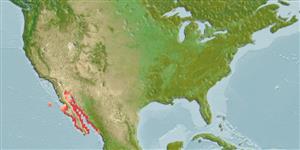>
Perciformes/Serranoidei (Groupers) >
Epinephelidae (Groupers)
Etymology: Mycteroperca: Greek, mykter, -eros = nose + Greek, perke = perch (Ref. 45335).
Eponymy: Dr David Starr Jordan (1851–1931) was a leading American ichthyologist, physician, educator, peace activist and believer in eugenics; moreover, he was founding President of Stanford University. [...] (Ref. 128868), visit book page.
More on authors: Jenkins & Evermann.
Environment: milieu / climate zone / depth range / distribution range
Ekologi
laut berasosiasi dengan karang; kisaran kedalaman 5 - 30 m (Ref. 9342). Subtropical; 33°N - 23°N, 119°W - 106°W (Ref. 5222)
Eastern Central Pacific: southern La Jolla, California, USA to Mazatlan, Mexico.
Size / Weight / umur
Maturity: Lm ? range ? - ? cm
Max length : 198 cm TL jantan/; (Ref. 2850); Berat maksimum terpublikasi: 91.0 kg (Ref. 5222)
deskripsi pendek
Kunci identifiaksi (pengenalan) | Morfologi | Morfometrik
Duri punggung (Keseluruhan (total)) : 11; duri punggung lunak (Keseluruhan (total)) : 16 - 17; Duri dubur: 3; Sirip dubur lunak: 10 - 11. Distinguished by the following characteristics: uniform dark brown or grey color of adults (can rapidly change into juvenile pattern when disturbed or under stress), large adults with white pectoral fin margin and median fins with narrow white edge; juvenile with greyish brown color, with dark spots along upper half of the body; depth of body 3.1-3.4 times in SL; head length 2.5-2.7 times in SL; rounded preopercle, finely serrate, lacking distinct lobe at the angle; posterior nostrils not notably enlarged, diameter less than twice of anterior nostrils (Ref. 89707).
Found in rocky reefs and kelp beds. Juveniles are unknown in California waters and the few large adults that have been taken there are probably expatriates from a more southerly breeding population. Large adults feed on fishes (Ref. 9342). Reported to prey on juvenile hammerhead sharks. Its large size makes it an object of game fishing (Ref. 9342).
Life cycle and mating behavior
Kematangan | Reproduksi, perkembang biakan | Pemijahan | telur-telur | Fecundity | Larva
Heemstra, P.C. and J.E. Randall, 1993. FAO Species Catalogue. Vol. 16. Groupers of the world (family Serranidae, subfamily Epinephelinae). An annotated and illustrated catalogue of the grouper, rockcod, hind, coral grouper and lyretail species known to date. Rome: FAO. FAO Fish. Synop. 125(16):382 p. (Ref. 5222)
Status IUCN Red List (Ref. 130435: Version 2024-1)
ancaman kepada manusia
Harmless
penggunaan manusia
Perikanan: nilai komersial kecil; Ikan buruan: ya
Alat, peralatan
laporan khas
muat turun XML
Sumber internet
Estimates based on models
Preferred temperature (Ref.
123201): 18.6 - 25.9, mean 23 °C (based on 102 cells).
Phylogenetic diversity index (Ref.
82804): PD
50 = 0.5000 [Uniqueness, from 0.5 = low to 2.0 = high].
Bayesian length-weight: a=0.00933 (0.00426 - 0.02047), b=3.05 (2.88 - 3.22), in cm total length, based on LWR estimates for this Genus-body shape (Ref.
93245).
Trophic level (Ref.
69278): 4.5 ±0.80 se; based on food items.
Daya lenting (Ref.
120179): sangat rendah, Waktu penggandaan populasi minimum lebih dari 14 tahun (Preliminary K or Fecundity.).
Fishing Vulnerability (Ref.
59153): Very high vulnerability (90 of 100).
Nutrients (Ref.
124155): Calcium = 8.75 [4.91, 18.12] mg/100g; Iron = 0.397 [0.198, 0.722] mg/100g; Protein = 19.5 [17.7, 21.3] %; Omega3 = 0.163 [0.086, 0.304] g/100g; Selenium = 19.6 [7.2, 42.9] μg/100g; VitaminA = 50.7 [13.8, 195.3] μg/100g; Zinc = 0.454 [0.295, 0.715] mg/100g (wet weight);
